Loading and Saving Excel document in OneDrive Cloud Storage
23 Jul 202522 minutes to read
Prerequisites
- Microsoft Azure subscription is required.
- Register an application in App Registrations within the Azure portal is required
- The Application (client) ID, Tenant ID, and Client Secret from the registered app are required for authentication and API access.
Loading Excel document from OneDrive
Steps to load an Excel document from OneDrive Cloud Storage.
Step 1: Create a new ASP.NET Core Web Application (Model-View-Controller).
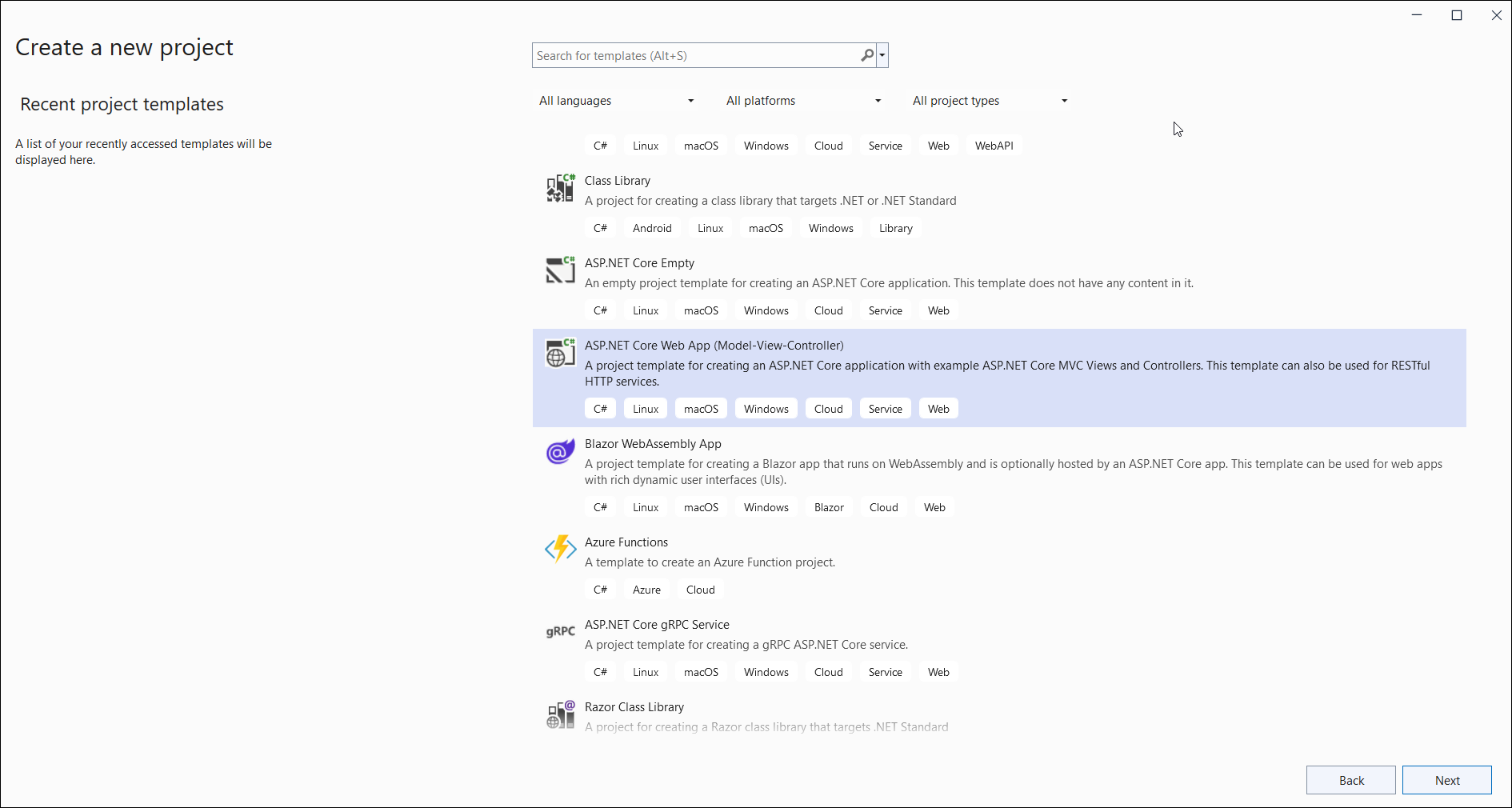
Step 2: Name the project.
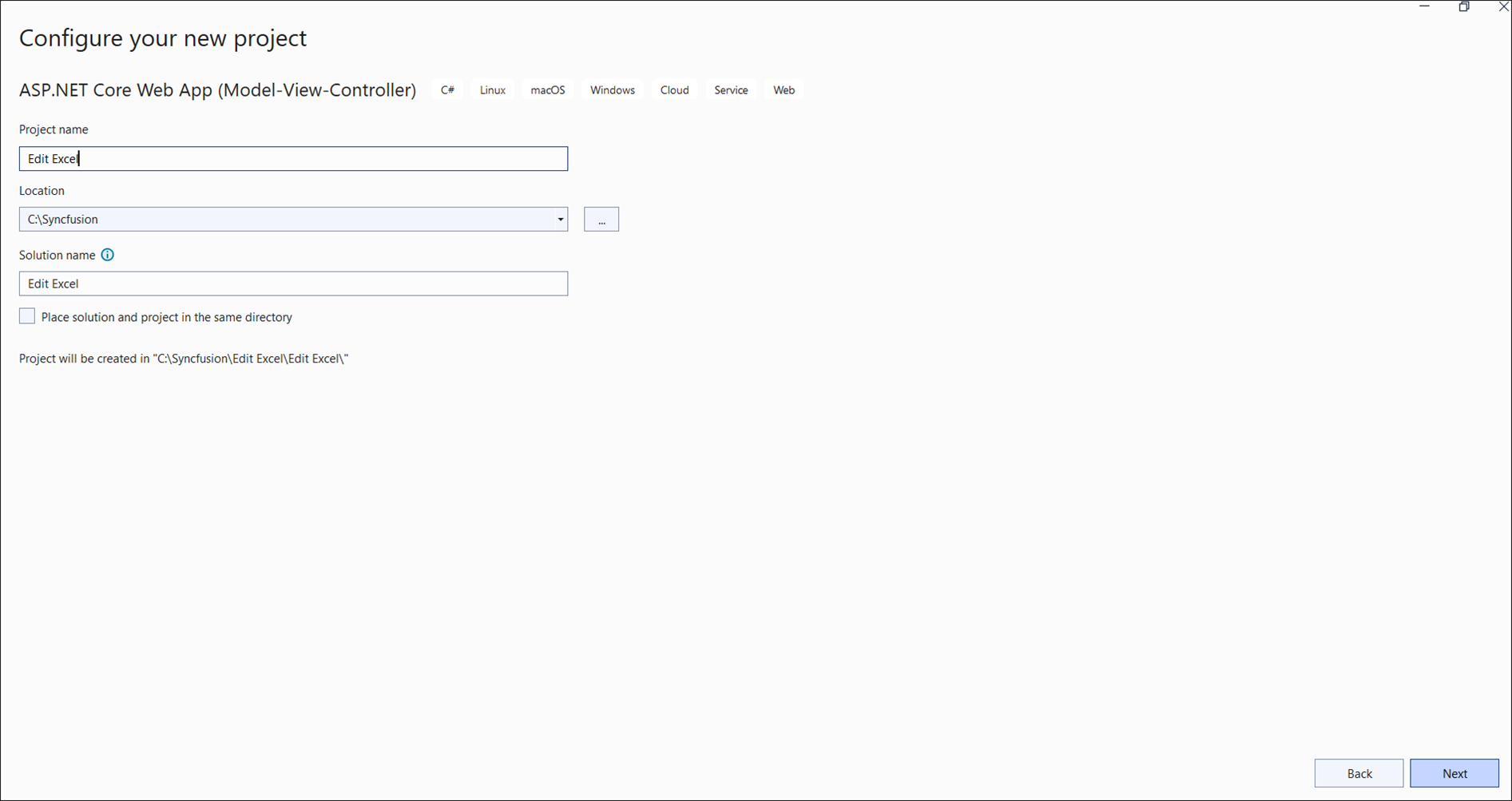
Step 3: Install the following Nuget packages in your application from NuGet.org.
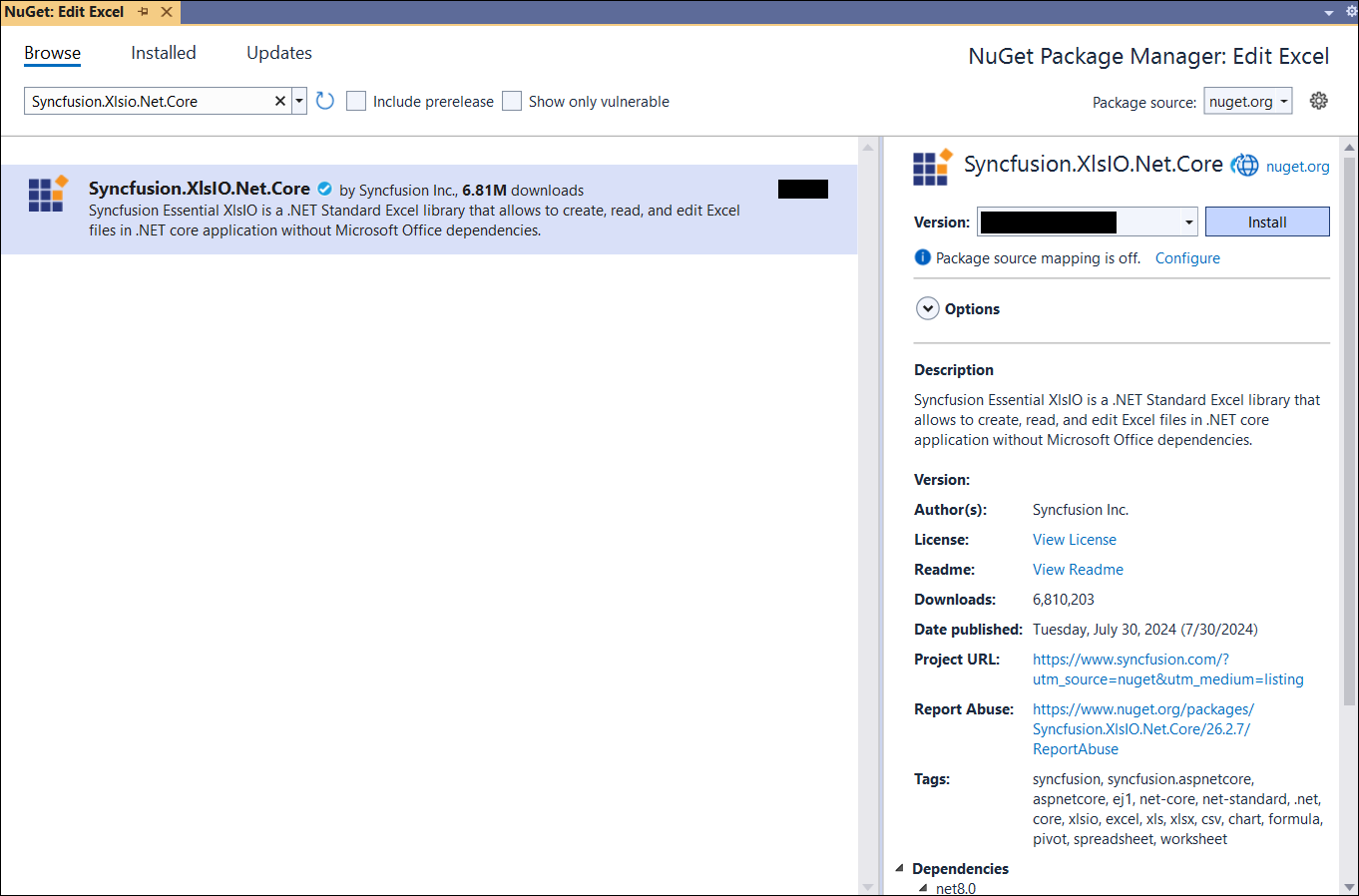
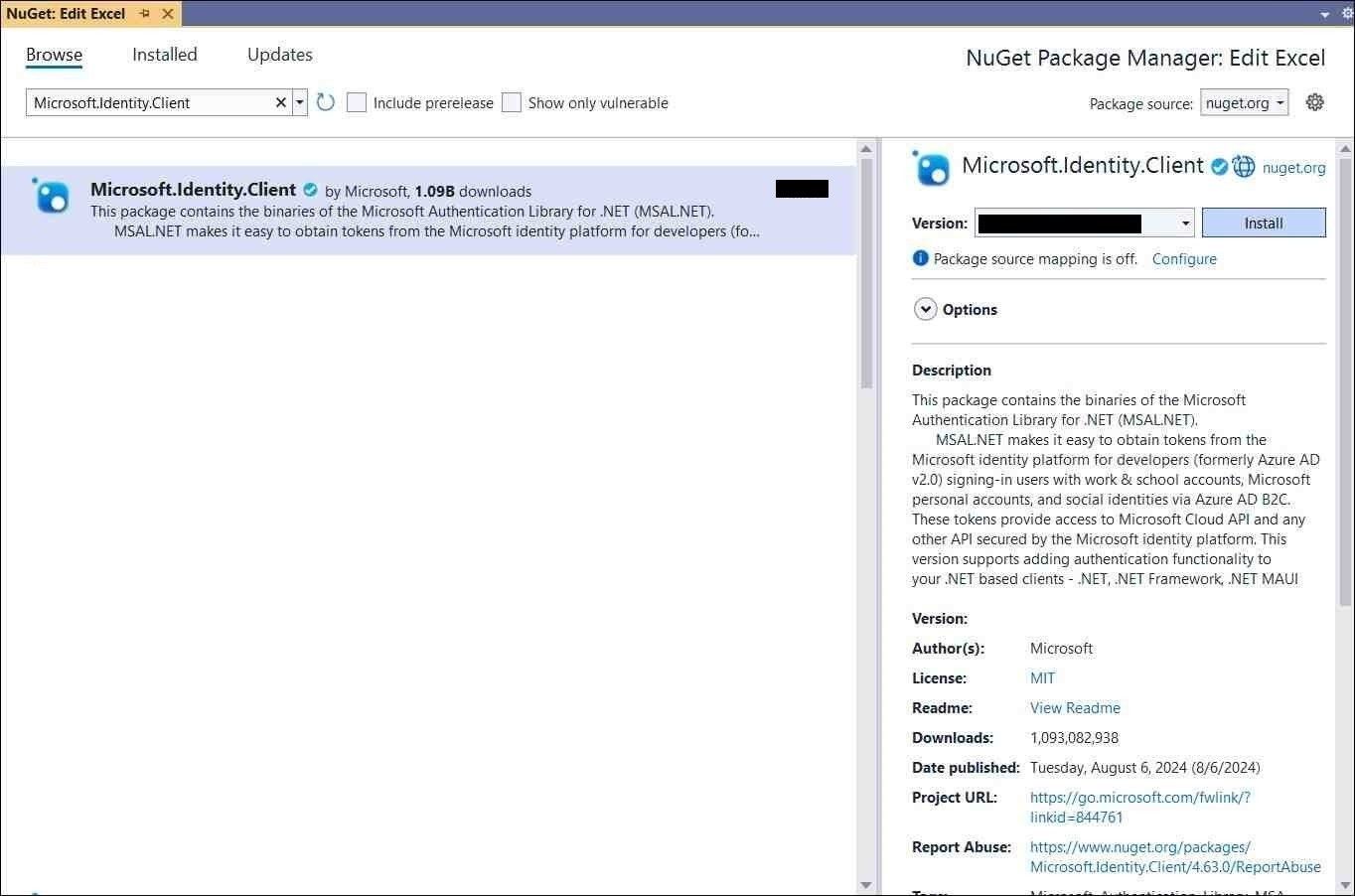
Step 4: Add a new button in the Index.cshtml as shown below.
@{Html.BeginForm("EditDocument", "Home", FormMethod.Get);
{
<div>
<input type="submit" value="Edit Document" style="width:150px;height:27px" />
</div>
}
Html.EndForm();
}Step 5: Include the following namespaces in HomeController.cs.
using Syncfusion.XlsIO;
using Syncfusion.Drawing;
using Microsoft.Identity.Client;Step 6: Include the below code snippet in HomeController.cs to load an Excel document from OneDrive Cloud Storage.
using (ExcelEngine excelEngine = new ExcelEngine())
{
IApplication application = excelEngine.Excel;
application.DefaultVersion = ExcelVersion.Xlsx;
//Download the document from OneDrive
MemoryStream stream = await DownloadDocumentFromOneDrive();
//Set the position as '0'
stream.Position = 0;
//Load the downloaded document
IWorkbook workbook = application.Workbooks.Open(stream);
IWorksheet worksheet = workbook.Worksheets[0];
worksheet.Range["A3"].Text = "Hello world";
//Saving the Excel to the MemoryStream
MemoryStream outputStream = new MemoryStream();
workbook.SaveAs(outputStream);
//Set the position as '0'
outputStream.Position = 0;
//Download the Excel file in the browser
FileStreamResult fileStreamResult = new FileStreamResult(outputStream, "application/excel");
fileStreamResult.FileDownloadName = "EditExcel.xlsx";
return fileStreamResult;
}
// Download file from OneDrive
public async Task<MemoryStream> DownloadDocumentFromOneDrive()
{
//Replace with your application (client) ID, tenant ID, and secret
string clientId = "your-client-id";
string tenantId = "your-tenant-id";
string clientSecret = "your-client-secret";
//Replace with the user ID (email address) whose OneDrive you want to access
string userId = "[email protected]";
//Replace with the OneDrive file path where you want to download the file For ex: "/Template.xlsx"
string filePath = "FilePath";
//Initialize the MSAL client
var confidentialClientApplication = ConfidentialClientApplicationBuilder
.Create(clientId)
.WithClientSecret(clientSecret)
.WithAuthority(new Uri($"https://login.microsoftonline.com/{tenantId}"))
.Build();
//Acquire an access token
string[] scopes = { "https://graph.microsoft.com/.default" };
var authenticationResult = await confidentialClientApplication
.AcquireTokenForClient(scopes)
.ExecuteAsync();
//Create an HTTP client with the access token
var httpClient = new HttpClient();
httpClient.DefaultRequestHeaders.Authorization = new AuthenticationHeaderValue("Bearer", authenticationResult.AccessToken);
//Construct the OneDrive download URL using user ID and file path
var downloadUrl = $"https://graph.microsoft.com/v1.0/users/{userId}/drive/root:{filePath}:/content";
//Download the file from OneDrive
var response = await httpClient.GetAsync(downloadUrl);
if (response.IsSuccessStatusCode)
{
var stream = new MemoryStream();
await response.Content.CopyToAsync(stream);
// Reset the stream position to the beginning
stream.Position = 0;
Console.WriteLine("File downloaded successfully.");
return stream;
}
else
{
Console.WriteLine($"Failed to download file. Status code: {response.StatusCode}");
string responseBody = await response.Content.ReadAsStringAsync();
Console.WriteLine($"Error details: {responseBody}");
return null;
}
}A complete working example of how to load an Excel document from OneDrive Cloud Storage in ASP.NET Core is present on this GitHub page.
By executing the program, you will get the Excel document as follows.
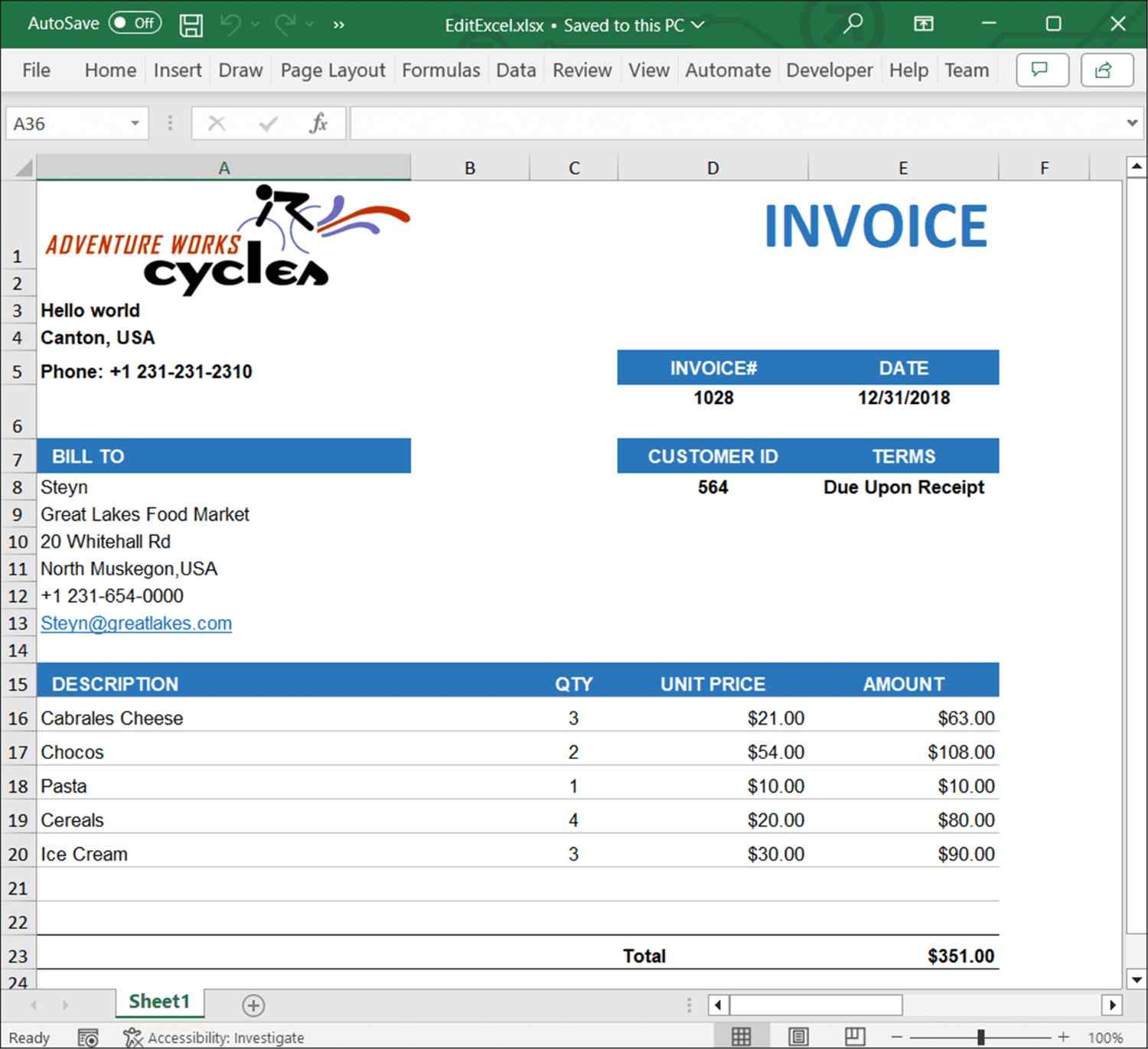
Saving Excel document to OneDrive
Steps to save an Excel document to OneDrive Cloud Storage.
Step 1: Create a new ASP.NET Core Web Application (Model-View-Controller).

Step 2: Name the project.
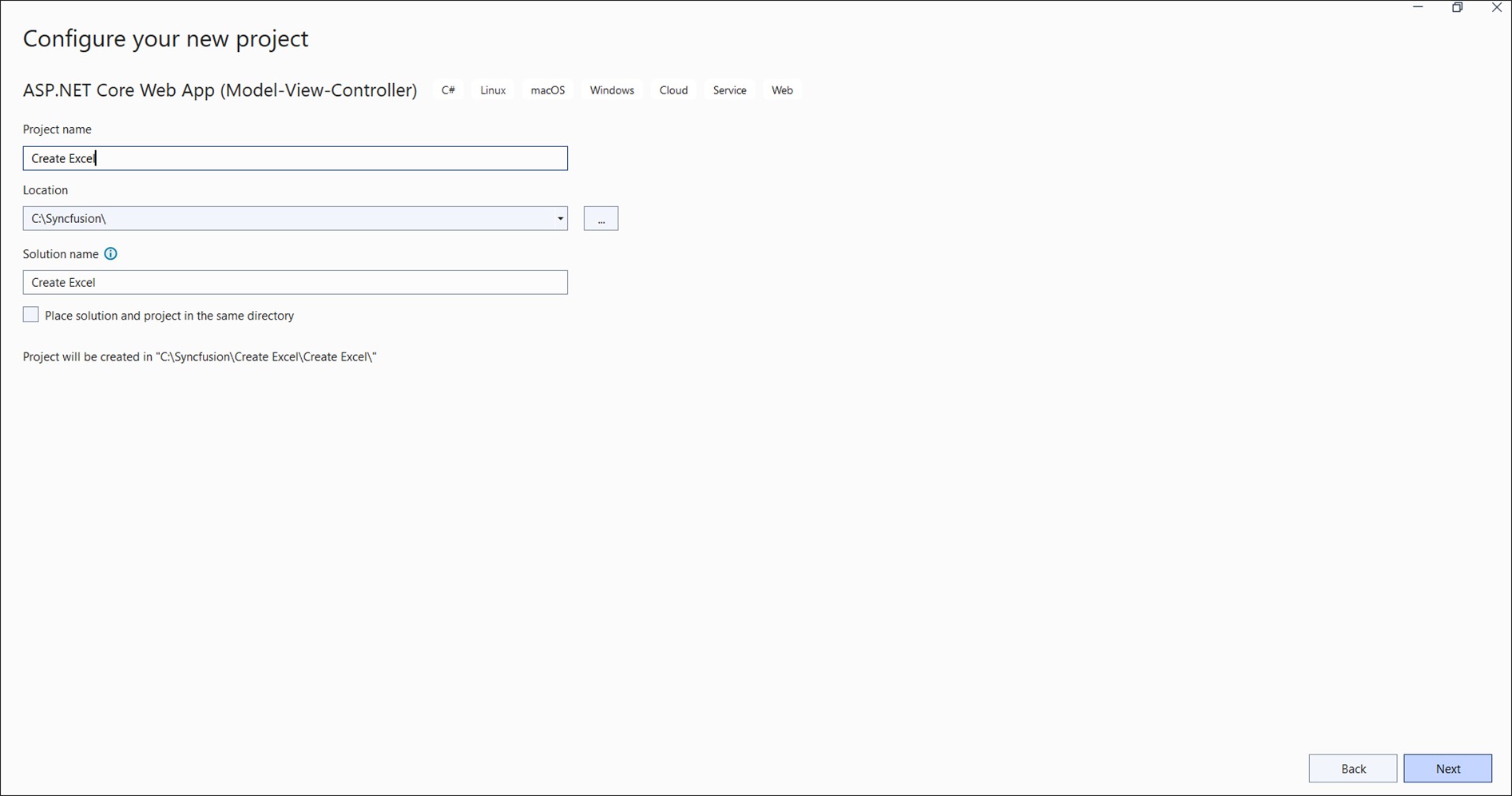
Step 3: Install the following Nuget packages in your application from NuGet.org.
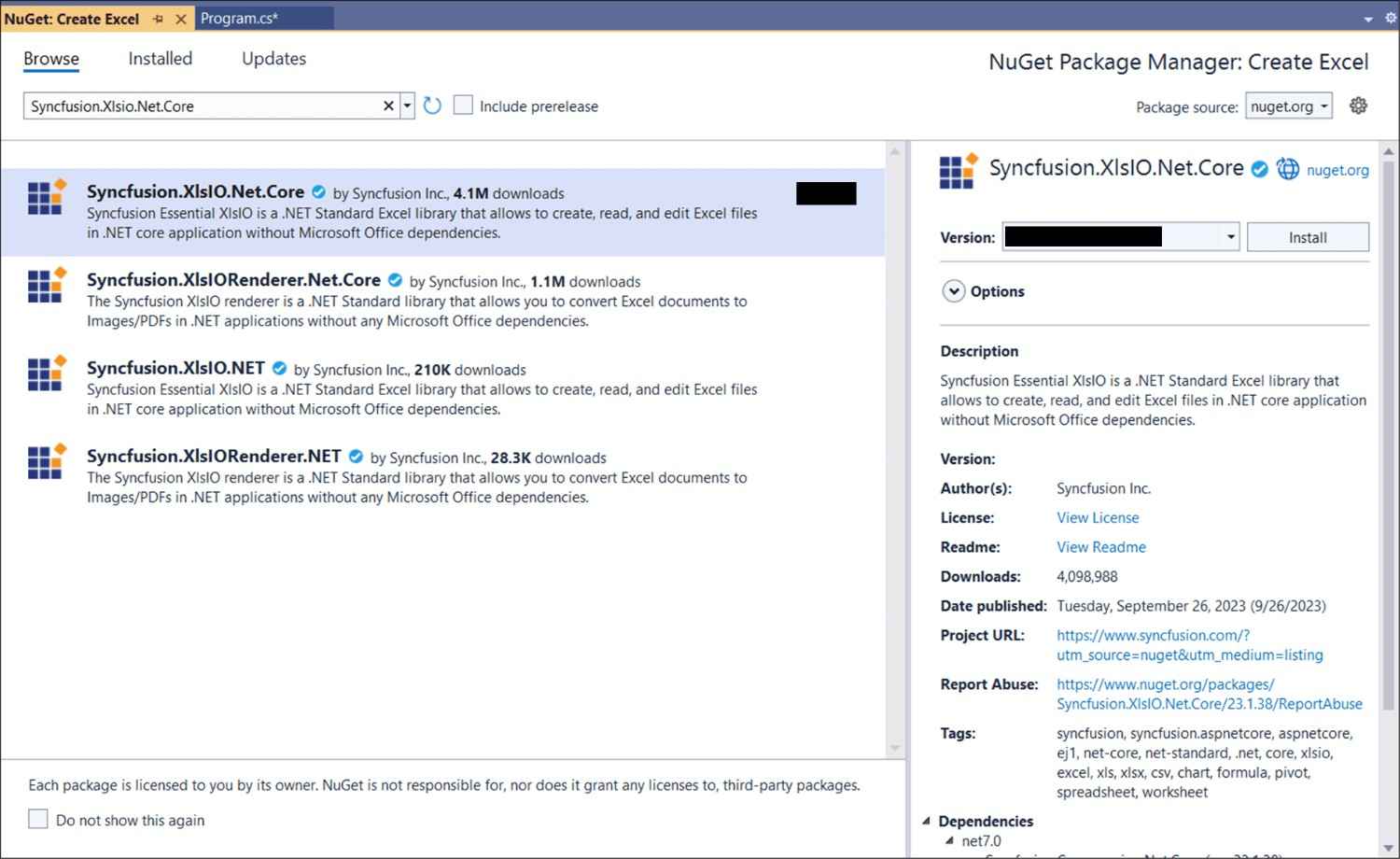
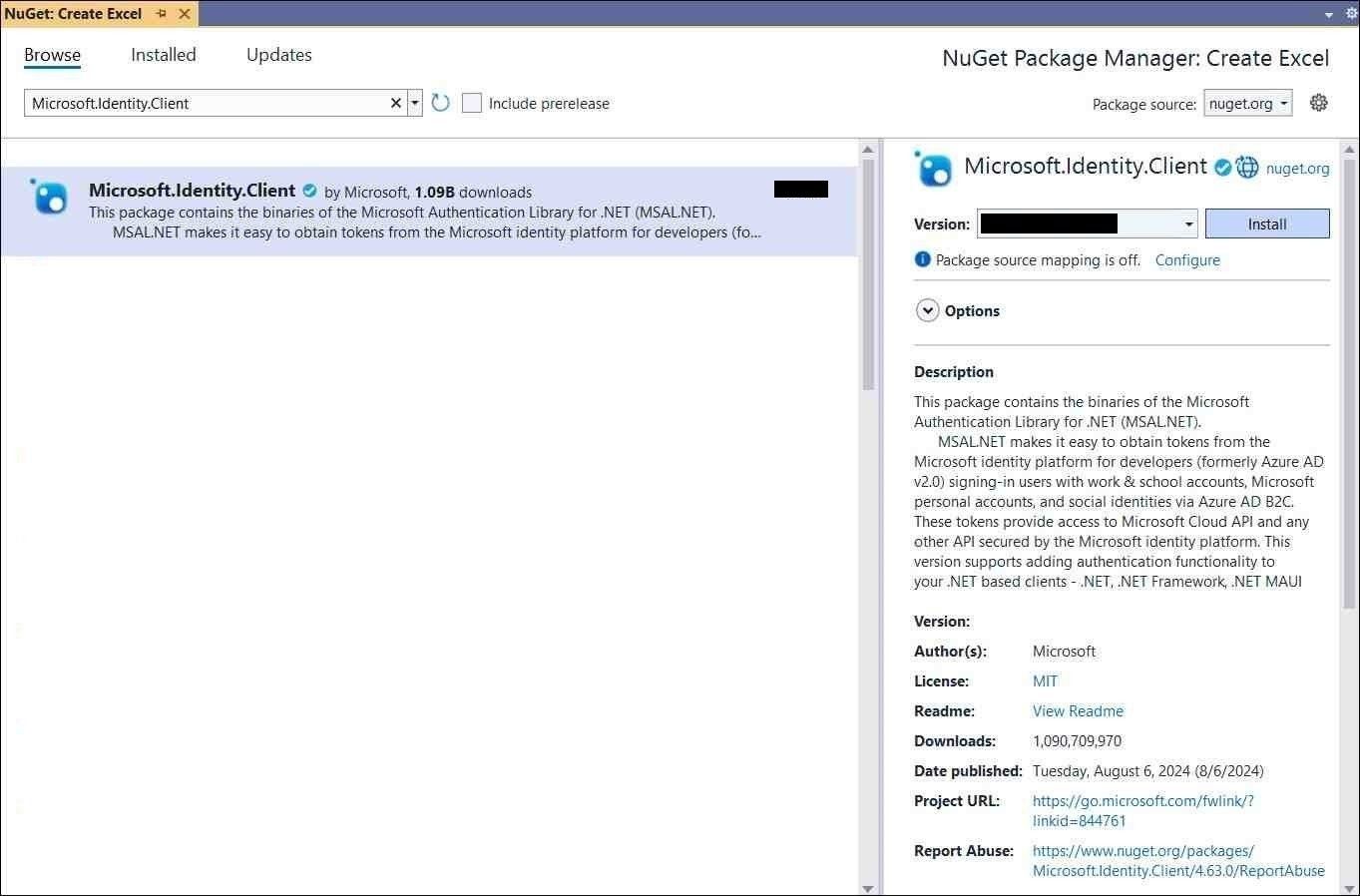
Step 4: Add a new button in the Index.cshtml as shown below.
@{Html.BeginForm("CreateDocument", "Home", FormMethod.Get);
{
<div>
<input type="submit" value="Upload Document" style="width:150px;height:27px" />
</div>
}
Html.EndForm();
}Step 5: Include the following namespaces in HomeController.cs.
using Syncfusion.XlsIO;
using Syncfusion.Drawing;
using Microsoft.Identity.Client;Step 6: Include the below code snippet in HomeController.cs to Save an Excel document to OneDrive Cloud Storage.
//Create an instance of ExcelEngine
using (ExcelEngine excelEngine = new ExcelEngine())
{
IApplication application = excelEngine.Excel;
application.DefaultVersion = ExcelVersion.Xlsx;
//Create a workbook
IWorkbook workbook = application.Workbooks.Create(1);
IWorksheet worksheet = workbook.Worksheets[0];
//Adding a picture
FileStream imageStream = new FileStream("AdventureCycles-Logo.png", FileMode.Open, FileAccess.Read);
IPictureShape shape = worksheet.Pictures.AddPicture(1, 1, imageStream, 20, 20);
//Disable gridlines in the worksheet
worksheet.IsGridLinesVisible = false;
//Enter values to the cells from A3 to A5
worksheet.Range["A3"].Text = "46036 Michigan Ave";
worksheet.Range["A4"].Text = "Canton, USA";
worksheet.Range["A5"].Text = "Phone: +1 231-231-2310";
//Make the text bold
worksheet.Range["A3:A5"].CellStyle.Font.Bold = true;
//Merge cells
worksheet.Range["D1:E1"].Merge();
//Enter text to the cell D1 and apply formatting.
worksheet.Range["D1"].Text = "INVOICE";
worksheet.Range["D1"].CellStyle.Font.Bold = true;
worksheet.Range["D1"].CellStyle.Font.RGBColor = Color.FromArgb(42, 118, 189);
worksheet.Range["D1"].CellStyle.Font.Size = 35;
//Apply alignment in the cell D1
worksheet.Range["D1"].CellStyle.HorizontalAlignment = ExcelHAlign.HAlignRight;
worksheet.Range["D1"].CellStyle.VerticalAlignment = ExcelVAlign.VAlignTop;
//Enter values to the cells from D5 to E8
worksheet.Range["D5"].Text = "INVOICE#";
worksheet.Range["E5"].Text = "DATE";
worksheet.Range["D6"].Number = 1028;
worksheet.SetValue(6, 5, "12/31/2018");
worksheet.Range["D7"].Text = "CUSTOMER ID";
worksheet.Range["E7"].Text = "TERMS";
worksheet.Range["D8"].Number = 564;
worksheet.Range["E8"].Text = "Due Upon Receipt";
//Apply RGB backcolor to the cells from D5 to E8
worksheet.Range["D5:E5"].CellStyle.Color = Color.FromArgb(42, 118, 189);
worksheet.Range["D7:E7"].CellStyle.Color = Color.FromArgb(42, 118, 189);
//Apply known colors to the text in cells D5 to E8
worksheet.Range["D5:E5"].CellStyle.Font.Color = ExcelKnownColors.White;
worksheet.Range["D7:E7"].CellStyle.Font.Color = ExcelKnownColors.White;
//Make the text as bold from D5 to E8
worksheet.Range["D5:E8"].CellStyle.Font.Bold = true;
//Apply alignment to the cells from D5 to E8
worksheet.Range["D5:E8"].CellStyle.HorizontalAlignment = ExcelHAlign.HAlignCenter;
worksheet.Range["D5:E5"].CellStyle.VerticalAlignment = ExcelVAlign.VAlignCenter;
worksheet.Range["D7:E7"].CellStyle.VerticalAlignment = ExcelVAlign.VAlignCenter;
worksheet.Range["D6:E6"].CellStyle.VerticalAlignment = ExcelVAlign.VAlignTop;
//Enter value and applying formatting in the cell A7
worksheet.Range["A7"].Text = " BILL TO";
worksheet.Range["A7"].CellStyle.Color = Color.FromArgb(42, 118, 189);
worksheet.Range["A7"].CellStyle.Font.Bold = true;
worksheet.Range["A7"].CellStyle.Font.Color = ExcelKnownColors.White;
//Apply alignment
worksheet.Range["A7"].CellStyle.HorizontalAlignment = ExcelHAlign.HAlignLeft;
worksheet.Range["A7"].CellStyle.VerticalAlignment = ExcelVAlign.VAlignCenter;
//Enter values in the cells A8 to A12
worksheet.Range["A8"].Text = "Steyn";
worksheet.Range["A9"].Text = "Great Lakes Food Market";
worksheet.Range["A10"].Text = "20 Whitehall Rd";
worksheet.Range["A11"].Text = "North Muskegon,USA";
worksheet.Range["A12"].Text = "+1 231-654-0000";
//Create a Hyperlink for e-mail in the cell A13
IHyperLink hyperlink = worksheet.HyperLinks.Add(worksheet.Range["A13"]);
hyperlink.Type = ExcelHyperLinkType.Url;
hyperlink.Address = "[email protected]";
hyperlink.ScreenTip = "Send Mail";
//Merge column A and B from row 15 to 22
worksheet.Range["A15:B15"].Merge();
worksheet.Range["A16:B16"].Merge();
worksheet.Range["A17:B17"].Merge();
worksheet.Range["A18:B18"].Merge();
worksheet.Range["A19:B19"].Merge();
worksheet.Range["A20:B20"].Merge();
worksheet.Range["A21:B21"].Merge();
worksheet.Range["A22:B22"].Merge();
//Enter details of products and prices
worksheet.Range["A15"].Text = " DESCRIPTION";
worksheet.Range["C15"].Text = "QTY";
worksheet.Range["D15"].Text = "UNIT PRICE";
worksheet.Range["E15"].Text = "AMOUNT";
worksheet.Range["A16"].Text = "Cabrales Cheese";
worksheet.Range["A17"].Text = "Chocos";
worksheet.Range["A18"].Text = "Pasta";
worksheet.Range["A19"].Text = "Cereals";
worksheet.Range["A20"].Text = "Ice Cream";
worksheet.Range["C16"].Number = 3;
worksheet.Range["C17"].Number = 2;
worksheet.Range["C18"].Number = 1;
worksheet.Range["C19"].Number = 4;
worksheet.Range["C20"].Number = 3;
worksheet.Range["D16"].Number = 21;
worksheet.Range["D17"].Number = 54;
worksheet.Range["D18"].Number = 10;
worksheet.Range["D19"].Number = 20;
worksheet.Range["D20"].Number = 30;
worksheet.Range["D23"].Text = "Total";
//Apply number format
worksheet.Range["D16:E22"].NumberFormat = "$.00";
worksheet.Range["E23"].NumberFormat = "$.00";
//Apply incremental formula for column Amount by multiplying Qty and UnitPrice
application.EnableIncrementalFormula = true;
worksheet.Range["E16:E20"].Formula = "=C16*D16";
//Formula for Sum the total
worksheet.Range["E23"].Formula = "=SUM(E16:E22)";
//Apply borders
worksheet.Range["A16:E22"].CellStyle.Borders[ExcelBordersIndex.EdgeTop].LineStyle = ExcelLineStyle.Thin;
worksheet.Range["A16:E22"].CellStyle.Borders[ExcelBordersIndex.EdgeBottom].LineStyle = ExcelLineStyle.Thin;
worksheet.Range["A16:E22"].CellStyle.Borders[ExcelBordersIndex.EdgeTop].Color = ExcelKnownColors.Grey_25_percent;
worksheet.Range["A16:E22"].CellStyle.Borders[ExcelBordersIndex.EdgeBottom].Color = ExcelKnownColors.Grey_25_percent;
worksheet.Range["A23:E23"].CellStyle.Borders[ExcelBordersIndex.EdgeTop].LineStyle = ExcelLineStyle.Thin;
worksheet.Range["A23:E23"].CellStyle.Borders[ExcelBordersIndex.EdgeBottom].LineStyle = ExcelLineStyle.Thin;
worksheet.Range["A23:E23"].CellStyle.Borders[ExcelBordersIndex.EdgeTop].Color = ExcelKnownColors.Black;
worksheet.Range["A23:E23"].CellStyle.Borders[ExcelBordersIndex.EdgeBottom].Color = ExcelKnownColors.Black;
//Apply font setting for cells with product details
worksheet.Range["A3:E23"].CellStyle.Font.FontName = "Arial";
worksheet.Range["A3:E23"].CellStyle.Font.Size = 10;
worksheet.Range["A15:E15"].CellStyle.Font.Color = ExcelKnownColors.White;
worksheet.Range["A15:E15"].CellStyle.Font.Bold = true;
worksheet.Range["D23:E23"].CellStyle.Font.Bold = true;
//Apply cell color
worksheet.Range["A15:E15"].CellStyle.Color = Color.FromArgb(42, 118, 189);
//Apply alignment to cells with product details
worksheet.Range["A15"].CellStyle.HorizontalAlignment = ExcelHAlign.HAlignLeft;
worksheet.Range["C15:C22"].CellStyle.HorizontalAlignment = ExcelHAlign.HAlignCenter;
worksheet.Range["D15:E15"].CellStyle.HorizontalAlignment = ExcelHAlign.HAlignCenter;
//Apply row height and column width to look good
worksheet.Range["A1"].ColumnWidth = 36;
worksheet.Range["B1"].ColumnWidth = 11;
worksheet.Range["C1"].ColumnWidth = 8;
worksheet.Range["D1:E1"].ColumnWidth = 18;
worksheet.Range["A1"].RowHeight = 47;
worksheet.Range["A2"].RowHeight = 15;
worksheet.Range["A3:A4"].RowHeight = 15;
worksheet.Range["A5"].RowHeight = 18;
worksheet.Range["A6"].RowHeight = 29;
worksheet.Range["A7"].RowHeight = 18;
worksheet.Range["A8"].RowHeight = 15;
worksheet.Range["A9:A14"].RowHeight = 15;
worksheet.Range["A15:A23"].RowHeight = 18;
//Saving the Excel to the MemoryStream
MemoryStream stream = new MemoryStream();
workbook.SaveAs(stream);
//Set the position as '0'.
stream.Position = 0;
//Upload the document to OneDrive
await UploadDocumentToOneDrive(stream);
return Ok("Excel document uploaded to OneDrive cloud Storage.");
}
// Upload file to OneDrive
public async Task<MemoryStream> UploadDocumentToOneDrive(MemoryStream stream)
{
//Replace with your application (client) ID, tenant ID, and secret
string clientId = "your-client-id";
string tenantId = "your-tenant-id";
string clientSecret = "your-client-secret";
//Replace with the user ID (email address) whose OneDrive you want to access
string userId = "[email protected]";
//Replace with the OneDrive file path where you want to save the file For ex: "/Template.xlsx"
string filePath = "FilePath";
//Initialize the MSAL client
var confidentialClientApplication = ConfidentialClientApplicationBuilder
.Create(clientId)
.WithClientSecret(clientSecret)
.WithAuthority(new Uri($"https://login.microsoftonline.com/{tenantId}"))
.Build();
//Acquire an access token
string[] scopes = { "https://graph.microsoft.com/.default" };
var authenticationResult = await confidentialClientApplication
.AcquireTokenForClient(scopes)
.ExecuteAsync();
//Create an HTTP client with the access token
var httpClient = new HttpClient();
httpClient.DefaultRequestHeaders.Authorization = new AuthenticationHeaderValue("Bearer", authenticationResult.AccessToken);
//Upload the file to OneDrive
var content = new StreamContent(stream);
content.Headers.ContentType = new MediaTypeHeaderValue("application/octet-stream");
//Construct the OneDrive upload URL using user ID and file path
var uploadUrl = $"https://graph.microsoft.com/v1.0/users/{userId}/drive/root:{filePath}:/content";
using (var response = await httpClient.PutAsync(uploadUrl, content))
{
if (response.IsSuccessStatusCode)
{
Console.WriteLine("File uploaded successfully.");
}
else
{
Console.WriteLine($"Failed to upload file. Status code: {response.StatusCode}");
string responseBody = await response.Content.ReadAsStringAsync();
Console.WriteLine($"Error details: {responseBody}");
}
}
return stream;
}A complete working example of how to save an Excel document to OneDrive Cloud Storage in ASP.NET Core is present on this GitHub page.
By executing the program, you will get the Excel document as follows.
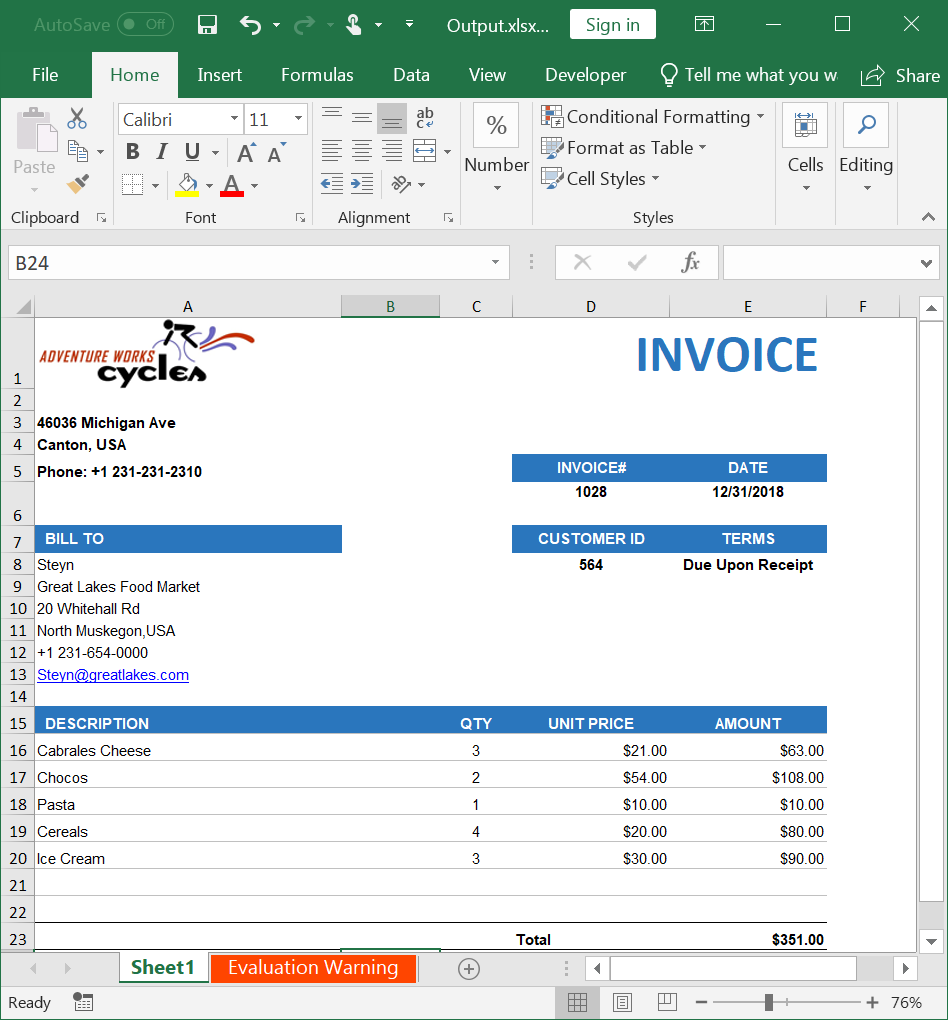
Click here to explore the rich set of Syncfusion® Excel library (XlsIO) features.
An online sample link to create an Excel document in ASP.NET Core.